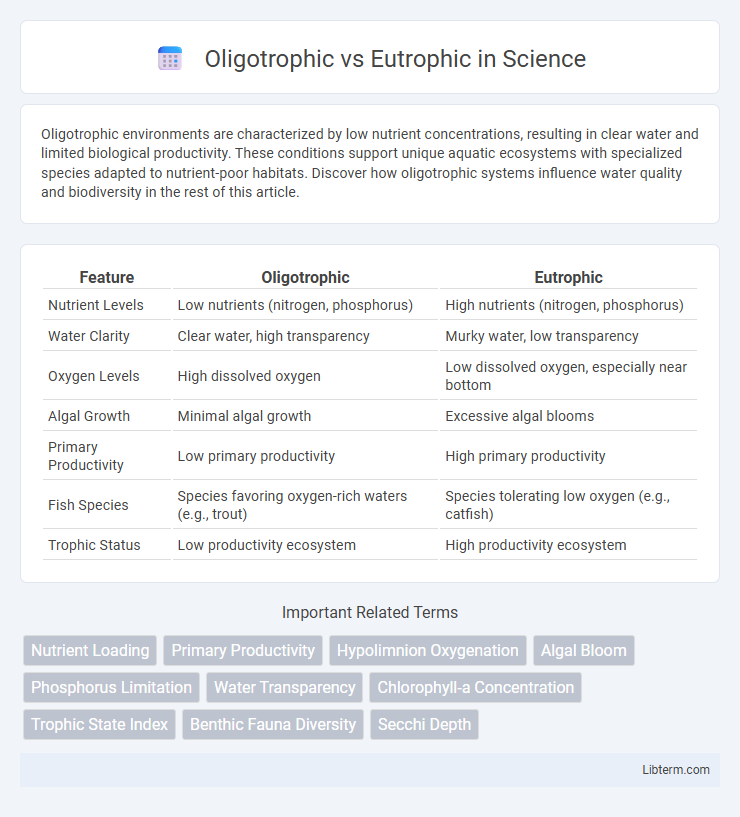Oligotrophic environments are characterized by low nutrient concentrations, resulting in clear water and limited biological productivity. These conditions support unique aquatic ecosystems with specialized species adapted to nutrient-poor habitats. Discover how oligotrophic systems influence water quality and biodiversity in the rest of this article.
Table of Comparison
| Feature | Oligotrophic | Eutrophic |
|---|---|---|
| Nutrient Levels | Low nutrients (nitrogen, phosphorus) | High nutrients (nitrogen, phosphorus) |
| Water Clarity | Clear water, high transparency | Murky water, low transparency |
| Oxygen Levels | High dissolved oxygen | Low dissolved oxygen, especially near bottom |
| Algal Growth | Minimal algal growth | Excessive algal blooms |
| Primary Productivity | Low primary productivity | High primary productivity |
| Fish Species | Species favoring oxygen-rich waters (e.g., trout) | Species tolerating low oxygen (e.g., catfish) |
| Trophic Status | Low productivity ecosystem | High productivity ecosystem |
Introduction to Oligotrophic and Eutrophic Waters
Oligotrophic waters are characterized by low nutrient concentrations, clear water, and high oxygen levels, supporting limited but specialized aquatic life. Eutrophic waters contain high nutrient levels, particularly nitrogen and phosphorus, leading to abundant plant growth and often resulting in lower oxygen levels due to decomposition. These contrasting conditions influence biodiversity, water quality, and ecosystem health in freshwater environments.
Defining Oligotrophic: Characteristics and Examples
Oligotrophic lakes are characterized by low nutrient levels, clear water, and high oxygen content throughout their depths, supporting diverse aquatic life adapted to nutrient-poor conditions. These lakes typically have low primary productivity and transparent water, often resulting in deep light penetration. Examples of oligotrophic lakes include Lake Tahoe in the United States and Lake Superior in North America, both known for their pristine water quality and minimal algal growth.
Understanding Eutrophic: Traits and Occurrences
Eutrophic lakes are characterized by high nutrient concentrations, particularly nitrogen and phosphorus, leading to abundant plant and algal growth that often causes decreased oxygen levels and poor water quality. These bodies of water commonly occur in areas with significant agricultural runoff, urbanization, or wastewater inflows, promoting rapid eutrophication. Traits include increased turbidity, frequent algal blooms, and a higher likelihood of hypoxic conditions affecting aquatic life and ecosystem balance.
Key Differences Between Oligotrophic and Eutrophic Ecosystems
Oligotrophic ecosystems have low nutrient levels, resulting in clear water, low primary productivity, and high oxygen concentrations, supporting species adapted to nutrient-poor conditions. Eutrophic ecosystems contain high nutrient concentrations, especially nitrogen and phosphorus, leading to excessive algae growth, reduced oxygen levels, and often hypoxic conditions affecting aquatic life. These differences influence biodiversity, water quality, and ecological functions, with oligotrophic lakes typically exhibiting greater water clarity and eutrophic lakes showing increased organic matter and periodic algal blooms.
Nutrient Levels and Water Quality
Oligotrophic waters exhibit low nutrient levels, particularly nitrogen and phosphorus, resulting in high water clarity and oxygen-rich environments ideal for diverse aquatic life. In contrast, eutrophic waters have elevated nutrient concentrations that promote excessive algal blooms, leading to decreased oxygen levels and poor water quality. The nutrient imbalance in eutrophic systems often triggers hypoxia, negatively impacting fish populations and overall ecosystem health.
Biological Productivity Comparison
Oligotrophic lakes exhibit low biological productivity due to limited nutrient availability, resulting in clear water and sparse aquatic vegetation. Eutrophic lakes have high nutrient concentrations, promoting abundant algal growth and dense plant life, which significantly increases biological productivity. The contrasting nutrient levels drive fundamental differences in ecosystem dynamics and organism populations between these two lake types.
Impacts on Aquatic Life and Biodiversity
Oligotrophic lakes characterized by low nutrient levels support diverse aquatic life with clear water and high oxygen content, fostering species that depend on well-oxygenated environments. Eutrophic lakes exhibit high nutrient concentrations, often leading to algal blooms, hypoxia, and reduced biodiversity due to oxygen depletion and habitat degradation. The nutrient imbalance in eutrophic systems causes shifts in species composition, favoring tolerant organisms while threatening sensitive aquatic life and overall ecosystem health.
Causes of Eutrophication
Eutrophication is primarily caused by excessive nutrient inputs, particularly nitrogen and phosphorus, from agricultural runoff, sewage discharge, and industrial effluents. These nutrients stimulate overgrowth of algae and aquatic plants, leading to oxygen depletion and harmful ecological imbalances in water bodies. In contrast, oligotrophic lakes have low nutrient concentrations, clear water, and support less algal growth, maintaining higher oxygen levels and biodiversity.
Human Activities Influencing Water Trophic Status
Human activities such as urban runoff, agricultural fertilizers, and wastewater discharge significantly increase nutrient loads in aquatic systems, shifting oligotrophic waters toward eutrophic conditions. Elevated phosphorus and nitrogen concentrations accelerate algal blooms and reduce water clarity, disrupting aquatic ecosystems and reducing biodiversity. Effective management of nutrient inputs and pollution control is crucial to restore and maintain desirable trophic statuses in water bodies.
Management and Preservation Strategies
Oligotrophic lakes require preservation strategies that focus on minimizing nutrient runoff through buffer zones, controlled land use, and limiting agricultural fertilizers to maintain their low nutrient status. Eutrophic lakes demand active management such as aeration, dredging, and biomanipulation to reduce excess nutrients and prevent algal blooms. Both types benefit from continuous water quality monitoring and public education to sustain ecological balance and water usability.
Oligotrophic Infographic

 libterm.com
libterm.com